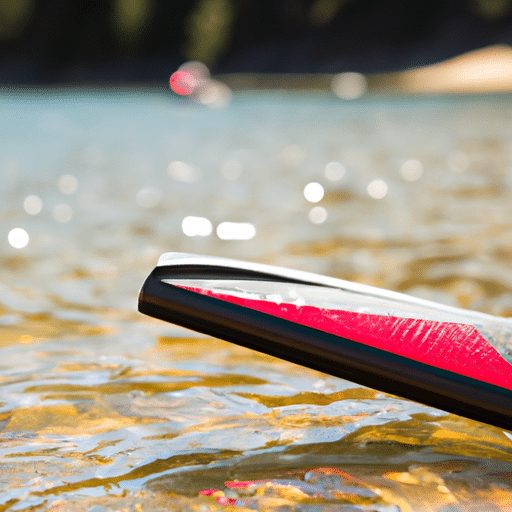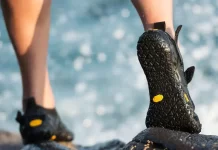When it comes to shopping for a SUP paddle, we are often bombarded with a plethora of options and features to consider. As avid paddleboard enthusiasts ourselves, we understand the excitement and confusion that comes with choosing the perfect paddle. That’s why we’ve compiled a handy guide to help you navigate through the sea of choices and find the paddle that’s right for you. Whether you’re a beginner or a seasoned pro, we’ve got you covered with essential features to look out for, from blade size and shape to shaft material and grip comfort. Get ready to paddle your way to a thrilling adventure on the water, armed with the knowledge of what makes a SUP paddle truly exceptional. When it comes to buying a SUP paddle, there are several important factors to consider. The material, length, blade shape and size, shaft, grip, weight, price, brand, and personal preferences all play a role in determining the best paddle for you. In this comprehensive guide, we will delve into each of these features to help you make an informed decision.
Material
The material of the SUP paddle is crucial in determining its durability, weight, and performance. Carbon fiber, fiberglass, and plastic or aluminum are the most common materials used for SUP paddles.
Carbon fiber paddles are known for their lightweight and excellent strength-to-weight ratio. They are highly popular among experienced paddlers who value performance and efficiency on the water. Fiberglass paddles, although slightly heavier than carbon fiber, offer similar performance characteristics at a more affordable price point. On the other hand, plastic or aluminum paddles are often the go-to choice for beginners or recreational paddlers due to their lower cost and durability.
Length
Choosing the right length of the SUP paddle is essential for a comfortable and efficient paddling experience. Several factors should be taken into consideration when determining the ideal length, including the paddler’s height, type of paddling, and SUP board width.
For most paddlers, a general rule of thumb is to choose a paddle that is approximately 8-10 inches taller than their height. This allows for a comfortable reach into the water without straining the upper body. However, if you primarily engage in surfing or paddling in rough conditions, a slightly shorter paddle may provide better maneuverability. Additionally, if you have a wider SUP board, you may need a longer paddle to reach comfortably into the water.
Blade Shape
The shape of the blade can greatly influence the performance and efficiency of the SUP paddle. There are several common blade shapes available, each with its own advantages and considerations.
Diagonal blades are often favored by paddlers who prioritize power and speed. The angled shape of the blade allows for efficient water catch and a powerful stroke. Rectangular blades, on the other hand, offer a more balanced approach, providing a mix of power and control. Tear-drop blades are known for their versatility, offering a good combination of power, control, and maneuverability. Scoop blades, with their concave shape, are highly efficient for long-distance paddling and can help reduce strain on the paddler’s muscles.
For those seeking a paddle tailored to their specific needs, custom blade shapes are also available. These blades can be designed to suit individual preferences and paddling styles, providing a truly personalized experience on the water.
Blade Size
Choosing the right blade size is crucial for optimizing paddling efficiency and avoiding excessive strain on the body. Several factors should be considered, including the paddler’s strength, skill level, and type of paddling.
Paddlers with more upper body strength can benefit from larger blades, as they provide more power with each stroke. However, it is important to consider the skill level of the paddler as well. Beginners or those with less experience may find larger blades more challenging to handle, resulting in early fatigue.
The type of paddling also plays a role in determining the ideal blade size. For recreational paddling or surfing, smaller blades can offer better maneuverability. In contrast, long-distance paddling or racing may require larger blades to generate sufficient power and efficiency.
Shaft
The shaft of the SUP paddle is responsible for connecting the blade to the handle, and it is important to choose the right shaft configuration for your needs. Two common options are adjustable shafts and fixed length shafts.
Adjustable shafts allow for customization of the paddle length, making them ideal for families or paddlers who share their equipment. This versatility can be particularly useful when paddling in varied conditions or with different SUP board widths.
Fixed length shafts, on the other hand, offer a more stable and seamless connection between the blade and handle. They are often favored by experienced paddlers who prefer a specific paddle length tailored to their height and paddling style.
The material of the shaft is also worth considering. Carbon fiber shafts are lightweight and provide excellent performance, but they often come at a higher price point. Aluminum shafts, while not as lightweight, offer durability and affordability.
Grip
A comfortable grip on the SUP paddle is essential for maintaining control and reducing fatigue during extended paddling sessions. The grip design and material are two important factors to consider.
Ergonomic design is key to a comfortable grip, as it allows for a more natural hand position and reduces strain on the wrist and forearm. Look for paddle grips that are shaped to fit the contours of the hand, providing optimal support and comfort.
The material of the grip is also important. Many paddlers prefer grippy materials such as rubber or foam, as they provide better traction and prevent slipping. Some paddles even feature textured grips to enhance grip and prevent the paddle from rotating in the hand.
Weight
The weight of the SUP paddle can greatly impact your paddling experience. A lighter paddle can reduce fatigue and make it easier to maneuver on the water. However, there are some considerations to keep in mind.
Lightweight paddles are often made from carbon fiber or other high-performance materials. While these paddles offer excellent performance, they often come at a higher price point. Additionally, they may be more prone to damage if not properly cared for. Heavier paddles, such as those made from fiberglass or plastic, can offer durability and affordability but may require more effort to paddle for extended periods.
Price
The price of a SUP paddle can vary widely depending on the brand, materials used, and additional features. It is important to consider your budget and balance it with the quality and performance you desire.
For those on a tighter budget, plastic or aluminum paddles can provide a cost-effective option without compromising on durability. Higher-end paddles made from carbon fiber or fiberglass will often come at a higher price, but they offer superior performance and weight savings.
When considering the price, it is important to also factor in the longevity of the paddle. A higher-quality paddle may require a larger upfront investment but can save you money in the long run by providing years of reliable performance.
Brand
Choosing a reputable brand can give you confidence in the quality and reliability of your SUP paddle. Reputable brands often have years of experience and a track record of producing high-quality products.
It can also be helpful to read customer reviews to gauge the overall satisfaction of previous buyers. Real-life experiences can provide valuable insights into the performance, durability, and customer service of a particular brand.
Personal Preferences
While the technical aspects of a SUP paddle are crucial, personal preferences should not be overlooked. Considerations such as color and design may seem minor, but they can enhance your enjoyment and connection with your paddle.
Choose a color that not only appeals to you but is also visible in the water. Bright colors can make it easier to spot your paddle if it falls into the water or if you are in a crowded area.
Design is also a personal preference that can reflect your individual style and personality. Some paddles feature unique patterns or artwork that can make your paddle stand out on the water and reflect your personal taste.
In conclusion, when buying a SUP paddle, it is important to consider several factors to ensure the best fit for your needs. The material, length, blade shape and size, shaft, grip, weight, price, brand, and personal preferences all play a role in determining the right paddle for you. By taking the time to assess these features and match them to your paddling style, you can enjoy a comfortable, efficient, and enjoyable paddling experience on the water.





































